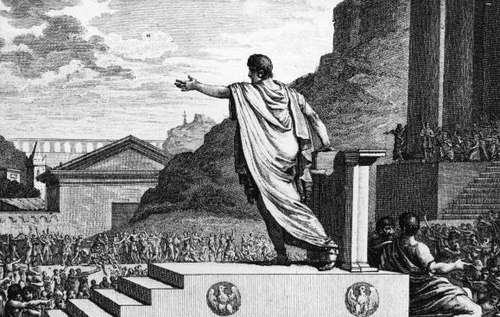Gracchi
The Gracchi brothers, Tiberius and Gaius, were Romans who both served as tribunes of the plebs between 133 and 121 BC. They attempted to redistribute the occupation of the ager publicus—the public land hitherto controlled principally by aristocrats—to the urban poor and veterans, in addition to other social and constitutional reforms. After achieving some early success, both were assassinated by the Optimates, the conservative faction in the senate that opposed these reforms.
 |
|---|
| This article is part of a series on the politics and government of ancient Rome |
| Periods |
|
| Roman Constitution |
| Precedent and law |
|
|
| Assemblies |
| Ordinary magistrates |
| Extraordinary magistrates |
| Titles and honours |
Early life
The brothers were born to a plebeian branch of the old and noble Sempronia family. Their father was the elderly Tiberius Gracchus the Elder (or Tiberius Sempronius Gracchus) who was tribune of the plebs, praetor, consul, and censor. Their mother was Cornelia, daughter of Scipio Africanus, himself considered a hero by the Roman people for his part in the war against Carthage. Their parents had 12 children, but only one daughter—who later married Scipio Aemilianus (Scipio Africanus the Younger)—and two sons, Tiberius and Gaius, survived childhood.[1]
After the boys' father died while they were young, responsibility for their education fell to their mother. Cornelia ensured that the brothers had the best available Greek tutors, teaching them oratory and political science. The brothers were also well trained in martial pursuits; in horsemanship and combat they outshone all their peers. The older brother Tiberius was elected an augur at only 16 – according to the historian J. C. Stobart, had he taken the easy path rather than the cause of radical reform, he would have been clearly destined for consulship. Tiberius was the most distinguished young officer in the Third Punic War, Rome's last campaign against Carthage. He was the first to scale Carthage's walls; before that he saved an army of 20,000 men by skilled diplomacy. As the boys grew up, they developed strong connections with the ruling elite.[1]
Gracchi reforms
Background
Central to the Gracchi reforms was an attempt to address economic distress and its military consequences. Much public land (ager publicus) had been divided among large landholders and speculators who further expanded their estates by driving peasants off their farms. While their old lands were being worked by slaves, the peasants were often forced into idleness in Rome where they had to subsist on handouts due to a scarcity of paid work. They could not legally join the army because they did not meet the property qualification; and this, together with the lack of public land to give in exchange for military service and the mutinies in the Numantine War, caused recruitment problems and troop shortages.
The Gracchi aimed to address these problems by reclaiming lands from wealthy members of the senatorial class that could then be granted to soldiers; by restoring land to displaced peasants; by providing subsidized grain for the needy and by having the Republic pay for the clothing of its poorest soldiers.[2]
Reforms of Tiberius Gracchus
Tiberius was elected to the office of Tribune of the Plebs in 133 BC. He immediately began pushing for a programme of land reform, partly by invoking the 240-year-old Sextian-Licinian law that limited the amount of land that could be owned by a single individual. Using the powers of Lex Hortensia, Tiberius established a commission to oversee the redistribution of land holdings from the rich to the unlanded urban poor. The commission consisted of himself, his father-in-law and his brother Gaius.[1]
Even liberal senators were agitated by the proposed changes, fearing their own lands would be confiscated. Senators arranged for other tribunes to oppose the reforms. Tiberius then appealed to the people, and argued that a tribune who opposes the will of the people in favour of the rich is not a true tribune. The senators were left with only one constitutional response – to threaten prosecution after Tiberius's term as a tribune ended. This meant Tiberius had to stand for a second term.[1]
The senators obstructed his re-election. They also gathered an ad hoc[lower-alpha 1] force, with several of them personally marching to the Forum, and had Tiberius and some 300 of his supporters clubbed to death. This was the first open bloodshed in Roman politics in nearly four centuries.[3]
Tiberius's land reform commission continued distributing lands, albeit much more slowly than Tiberius had envisaged, as Senators were able to eliminate more of the commission's supporters by legal means.
Reforms of Gaius Gracchus

Ten years later, in 123 BC, Gaius took the same office as his brother, as a Tribune of the Plebs. Gaius was more practically minded than Tiberius and consequently was considered more dangerous by the senatorial class. He gained support from the agrarian poor by reviving the land reform programme and from the urban poor with various popular measures. He also sought support from the second estate, those equestrians who had not ascended to become senators.
Many equestrians were publicans, in charge of tax collecting in the Roman province of Asia (located in western Anatolia), and of contracting for construction projects. The equestrian class would get to control a court that tried senators for misconduct in provincial administration. In effect, the equestrians replaced senators already serving at the court. Thus, Gaius became an opponent of senatorial influence. Other reforms implemented by Gaius included fixing prices on grain for the urban population and granting improvements in citizenship for Latins and others outside the city of Rome.
With this broad coalition of supporters, Gaius held his office for two years and had much of his prepared legislation passed. This included winning an unconstitutional re-election to the one-year office of Tribune.[2] However Gaius's plans to extend rights to non-Roman Italians were eventually vetoed by another Tribune. A substantial proportion of the Roman poor, protective of their privileged Roman citizenship, turned against Gaius.[1] With Gaius's support from the people weakened, the consul Lucius Opimius was able to crush the Gracchan movement by force. A mob was raised to assassinate Gaius. Knowing his death was imminent, he committed suicide on the Aventine Hill in 121 BC. All of his reforms were undermined except for the grain laws. Three thousand supporters were subsequently arrested and put to death in the proscriptions that followed.
Assessment and reasons for failure
According to the classicist J. C. Stobart, Tiberius's Greek education had caused him to overestimate the reliability of the people as a power base, causing him to overplay his hand. In Rome, even when led by a bold Tribune, the people enjoyed much less influence than at the height of the Athenian democracy. Another problem for Gaius's aims was that the Roman constitution, specifically the Tribal Assembly, was designed to prevent any one individual governing for a sustained period of time – and there were several other checks and balances to prevent power being concentrated on any one person. Stobart adds that another reason for the failure was the Gracchi's idealism: they were deaf to the baser notes of human nature and failed to recognize how corrupt and selfish all sections of Roman society had become.[1]
According to Oswald Spengler, the characteristic mistake of the Gracchan age was to believe in the possibility of the reversibility of history[4] – a form of idealism which according to Spengler was at that time shared by both sides of the political spectrum – Cato had sought to turn back the clock to the time of Cincinnatus, and restore virtue by returning to austerity.[1]
The philosopher Simone Weil ranked the conduct of the Gracchi second out of all the known cases of good-hearted conduct recorded by history for classical Rome, ahead of the Scipios and Virgil.[5][lower-alpha 2]
Historian Michael Crawford attributes the disappearance of much of Tiberius Gracchus' support to the reduced level of citizen participation due to dispersal far from Rome, and sees his tribunate as marking a step in the Hellenization of the Roman aristocracy. Crawford asserts that Gaius Gracchus' extortion law shifted the balance of power in Rome and that the Gracchi made available a new political armoury which the oligarchy subsequently sought to exploit.[6]
Aftermath
The emergence of new forces of urban factions, rural voters, and others, engaging in continued conflict with each other for their own interests, meant that the problem of effective governance awaited resolution. The reforms of the Gracchi had come to an end by violence; and this provided a brutal precedent that would be followed by many future rulers of Rome.[7]
Notes
- Latin: "for this purpose; literally "towards this" – the force being assembled for the specific purpose of deposing Tiberius as a tribune.
- Weil gives first ranking to Gaius Plotius Plancus and his slaves. During the proscriptions of the Second Triumvirate, the slaves endured torture so as to protect their master, the master seeing this came out of hiding to spare his slaves further pain and was executed.
References
- Stobart, J.C. (1978) [1964]. "III". In Maguinness, W.S; Scullard, H.H. (eds.). The Grandeur That was Rome (4th ed.). Book Club Associates. pp. 75–82.
- Tom Holland (2004). Rubicon: The Last Years of the Roman Republic. Abacus. pp. 28–30. ISBN 9780349115634.
- Nigel Rodgers, Hazel Dodge (2005). Rome: The Greatest Empire. Southwater. p. 24. ISBN 978-1-84476-150-0.
- Spengler, Oswald (1922). The Decline of the West(An abridged edition). Vintage Books, 2006. p. 384. ISBN 978-1-4000-9700-5.
- Simone Weil (2002). The Need for Roots. Routledge. p. 228. ISBN 978-0-415-27102-8.
- Crawford, Michael (1992). The Roman Republic (2nd ed.). London: Fontana. pp. 110–111, 121–123. ISBN 9780006862505.
- Bauer, Susan (2007). The History of the Ancient World.
Further reading
- Badian, E. (1984). Foreign Clientelae, 264–270 BC. New York: Oxford University Press.
- Bernstein, Alvin H. (1978). Tiberius Sempronius Gracchus : tradition and apostasy. Ithaca: Cornell University Press. ISBN 978-0-8014-1078-9.
- Boren, Henry C. (1969). The Gracchi. New York: Twayne.
- DeLeon, Daniel (1902). "The Warning of the Gracchi," p. 42 in Two Pages From Roman History (PDF). New York: New York Labor News.
- Earl, Donald C. (1963). Tiberius Gracchus : a study in politics. Bruxelles-Berchem: Latomus.
- Oman, Charles (1903). Seven Roman statesmen of the later republic : the Gracchi, Sulla, Crassus, Cato, Pompey, Caesar (3rd ed.). New York: Longmans, Green, and Co. OL 24152141M.
- Plutarch (1926). Plutarch's Lives. Bernadotte Perrin, trans. Cambridge, MA: Harvard University Press.
- Richardson, Keith (1976). Daggers in the Forum. London: Cassell. ISBN 978-0-304-29540-1.
- Riddle, John M. (1970). Tiberius Gracchus: destroyer or reformer of the Republic?. Lexington, MA: Heath.
- Scullard, H.H. (2010) [1959]. From the Gracchi to Nero : a history of Rome 133 BC to AD 68. London: Routledge. ISBN 978-0-415-58488-3.
- Stockton, David, ed. (1985). From The Gracchi To Sulla : sources for Roman history, 133-80B.C. Harrow: London Association of Classical Teachers. ISBN 978-0-903625-16-6.
- Stockton, David (1979). The Gracchi. Oxford: Clarendon Press. ISBN 978-0-19-872104-8.
External links
| Library resources about Gracchi |